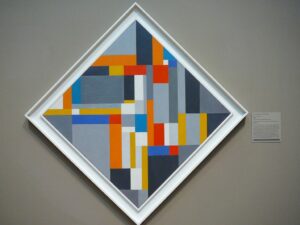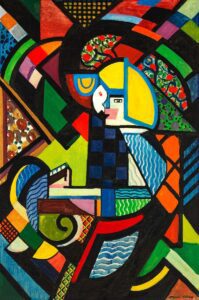Neogeo in art is a fascinating movement that redefines the boundaries of abstraction and technology.
It’s where geometric precision meets the digital revolution, creating a visual language that’s both nostalgic and futuristic.
We’ll explore how this style emerged and its impact on the contemporary art scene.
Stick with us to uncover the essence of Neogeo and why it’s captivating artists and collectors alike.
Origins Of Neogeo In Art
The genesis of Neogeo can be traced back to the early 1980s when the art world began to experience a shift towards an ostensibly cooler, more intellectual form of expression that leaned heavily on the technological advancements of the time.
This was a period marked by a reevaluation of the materials and methods used by artists, leading to a blending of various mediums that had not previously been combined.
At the forefront of this avant-garde movement were artists looking to break free from the emotional intensity and spontaneity of Abstract Expressionism.
The Neogeo style emerged as a direct response, showcasing an embrace of:
- Digital innovation,
- Crisp geometric shapes,
- Aesthetic of precision and orderliness.
The movement gained momentum with the introduction of computer-aided design tools that facilitated the creation of the precise geometric patterns characteristic of Neogeo.
The soaring interest in video and film as art forms during this era also played a significant role, with many Neogeo pieces featuring elements that paralleled the meticulous framing and composition found in cinematography.
Key exhibitions began to showcase Neogeo art, solidifying its presence in the contemporary art scene.
Galleries displayed paintings, sculptures, and installations where the influence of digital precision and geometric order was unmistakable.
For us at filmmaking lifestyle, the parallels between Neogeo art and the meticulous framing of a camera’s lens are particularly striking, underscoring the symbiotic relationship between technological progress in art and film.
Characteristics And Elements Of Neogeo
As experts deeply involved in the film and broader creative arts, we’ve observed that Neogeo comprises distinctive elements and characteristics that set it apart from other art movements.
Predominantly, its aesthetic echoes the digital innovation of the era and it features several defining traits:
- A clean, minimalist approach that emphasizes geometric shapes,
- An emphasis on structure and order, reflecting a machine-like precision,
- Artworks that exhibit a cool detachment, eschewing the emotionally charged gestures of previous eras.
Artists engaged with Neogeo tend to experiment with materials that were novel at the time, using synthetics and industrial components to further the dialogue between art and technology.
Neogeo pieces often feel like a still from a highly stylized film.
Artworks such as Cross Hatch and installations like Virtual Reality Gradient serve as perfect exemplars, featuring a cinematic crispness and a narrative that unfolds through space rather than time.

These pieces project an aura of engineered permanence – precisely arranged to frame each viewer’s experience.
Moving through the gallery spaces where Neogeo thrives, audiences encounter sculptures and installations that seem to pull them into a carefully choreographed sequence.
Just as the best films guide our gaze through a scene, Neogeo art directs our attention with purposeful composition:
- Use of bold, unambiguous color palettes,
- Integrated technology, such as light boxes or LEDs,
- Sculptures that often play with perception and space using reflective materials, showcasing the confluence of reality and technology.
By harnessing these methods, Neogeo stands as a testament to the artistic exploration of our relationship with an increasingly digital world.
Our scrutiny of this movement reveals a profound engagement with the tools and concepts that shape our visual culture, both in art and in our filmic endeavors.
Neogeo’s deliberate approach in marrying art with the mechanized and digitized facets of our reality opens up avenues for broader discussions – how technology informs our aesthetic trajectories and what it means for future visual narratives.
Influence Of Technology On Neogeo
The advent of the digital age has imprinted its signature on the canvas of Neogeo art.

Our exploration reveals that the technological zeitgeist of the late 20th century catalyzed a symbiosis between computational aesthetics and artistic expression.
Neogeo artists have harnessed the precision and capabilities of modern tech to refine their vision – So blurring the lines between art and engineered design.
Integration of digital tools has allowed for an expansion of the Neogeo vocabulary.
We’ve seen creators employ:
- Computer-aided design (CAD) software to conjure intricate geometric shapes,
- Digital manipulation to conjure pristine surfaces undefiled by the human touch,
- LED lighting and video screens to introduce dynamic elements in static compositions.
These methodologies are not merely adjuncts to the Neogeo aesthetic; they’ve become foundational.
The crisp edges and meticulous arrangements that are synonymous with the movement are often the results of these digital techniques.
Artworks like Replicants exemplify how the calculated use of technology can lead to creations that narrate stories of an immaculate future.
We observe that the fusion of technology with art does more than redefine the medium – it remodels the viewer’s engagement.
Interactive installations resonate with our innate curiosity for tactile experiences while subverting traditional viewing paradigms.
The role of spectator evolves, transforming passive observation into a form of dialogue, a feature particularly notable in pieces such as Synthetic Conversations.
It’s clear that the conversation between Neogeo artists and their tools is far from over.
They continue to push boundaries, drafting the blueprint for the next horizon of artistic innovation.
Just as cinema evolved with the onset of CGI, so too does Neogeo evolve with the advancements of digital technology, adding layers of complexity and new textures to its narrative.
Neogeo’s Impact On Contemporary Art
Neogeo, as a striking contribution to the contemporary art scene, has infused the domain with its characteristic geometric precision and high-tech flair.
Our fascination with this movement stems from its deliberate merger of form and function, which has distilled a new essence into the canvas of modern artists.
This movement’s integration with today’s technological toolkit has profoundly affected the creative processes.
For instance, the use of computer-aided design programs enables the production of artwork that was once unimaginable, fostering a richer dialogue between the artist’s imagination and practical execution.
Technological Tools Shaping The Creative Landscape
- The proliferation of 3D printing technology,
- Advances in digital animation software,
- The emergence of virtual and augmented reality platforms.
These innovations have not only altered the way artists create but also how audiences interact with art.
Interactive installations and digital sculptures meld Neogeo aesthetics with participatory experiences, disrupting the traditional spectator relationship.
Amidst these developments, Neogeo serves as the linchpin connecting the physical and digital artistic spheres.
It’s intriguing to observe how the starkness characteristic of this movement finds new life through mediums that invite immersive and multisensory encounters.
Video art, often embracing Neogeo, taps into our realm of expertise.
It challenges us to reimagine storytelling by incorporating structured design principles into filmic narratives.

The exciting aspect of this artistic interplay is its boundless potential for evolution.
As filmmakers and enthusiasts of all artistic currents, the imprints of Neogeo are evident in the visual language that permeates diverse creative fields, ranging from graphic design to architecture.
By staying informed of these artistic crosscurrents, we enrich our understanding of visual culture and enhance the content we bring forth to our audience.
Neogeo Artists And Their Works
Exploring Neogeo art means delving into the works of pioneering artists who redefine geometry in art through technology.
Through the lense of filmmaking, these innovators translate the precision and abstraction found in Neogeo to the dynamic world of moving images.
A central figure in the Neogeo movement is Peter Halley, whose bold, colorful canvases reflect the digital labyrinth of the modern era.
His seminal piece Exploding Cell employs vivid hues and rectangular shapes synonymous with the digital space we navigate daily.
Another illustrious name is Ashley Bickerton, who merges technology with commentary on consumerism in memorable installations.
Bickerton’s Tormented Self-Portrait (Susie at Arles) challenges viewers with its juxtaposition of high-tech materials and introspective content.
Here are notable works from top Neogeo artists – – Perfect Vehicles by Allan McCollum showcases the pristine repetition and mass production emblematic of the age.
- The Anthropometry of The Blue Period created by Yves Klein uses performance art to capture raw human presence, a concept further explored through the lens of video art in contemporary applications.
Advancements in digital animation and 3D modeling breathe life into Neogeo concepts on the silver screen.
Films such as TRON and The Matrix have employed Neogeo principles, visually representing information flow and virtual realms.
Technology not only dictates the mediums through which Neogeo artists create but also infuses their work with a unique, often thought-provoking aesthetic.
The tactility of mediums like sculpture transforms under the hand of artists like Tara Donovan, who reimagines everyday materials through a geometric lens in works like Untitled (Mylar).
By embracing the ever-evolving suite of digital tools, Neogeo artists continue to push the boundaries of what’s possible in film and interactive experiences.
Their works remain landmarks in the journey of art intersecting with ever-advancing technology.
What Is Neogeo In Art – Wrap Up
We’ve seen Neogeo art redefine boundaries and influence various creative industries.
By embracing digital tools, artists have unlocked new dimensions of geometric expression and interactivity.
It’s clear that Neogeo’s fusion of art and technology is not just a trend but a transformative movement that’s here to stay.
As technology progresses, we can only anticipate more groundbreaking works that challenge our perception of art and its place in the digital age.
Let’s continue to watch this space for the next wave of Neogeo innovations that will undoubtedly captivate our imaginations.
Frequently Asked Questions
What Is Neogeo Art?
Neogeo art is a contemporary artistic movement that incorporates geometric shapes and patterns, often utilizing digital tools and technology to create and interact with works.
How Has Technology Impacted Neogeo Art?
Technology has expanded Neogeo’s vocabulary by providing tools such as 3D printing, digital animation, and virtual/augmented reality, allowing for more complex creations and immersive experiences.
What Tools Do Neogeo Artists Commonly Use?
Neogeo artists frequently use 3D printing, digital animation software, and virtual and augmented reality platforms to produce their artworks.
Who Are Some Notable Neogeo Artists?
The article mentions several influential Neogeo artists, highlighting their contributions to the movement, though specific names are not provided in the summary.
In What Way Has Neogeo Art Influenced The Film Industry?
Advancements in digital animation and 3D modeling have brought Neogeo concepts to the silver screen, influencing the aesthetic of films and interactive experiences.
How Do Audiences Interact Differently With Neogeo Art Due To Technology?
Technological innovations in Neogeo art have led to more dynamic interactions, as audiences can engage with art in a multi-sensory and immersive manner that traditional static artworks could not offer.
Can Neogeo Concepts Be Applied To Other Creative Fields?
Yes, the principles of Neogeo, along with its use of technology, have a significant influence on diverse creative fields, pushing the boundaries and blending different art forms.





